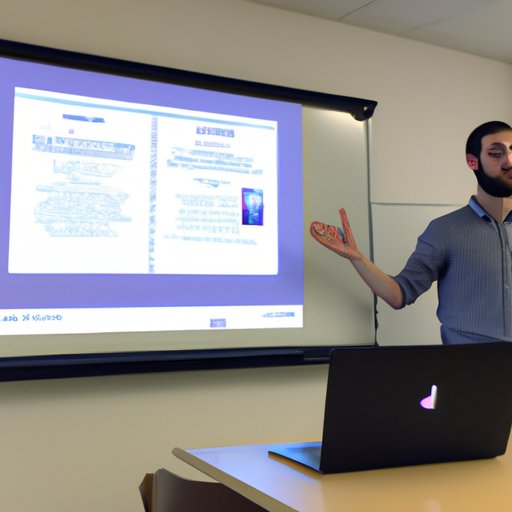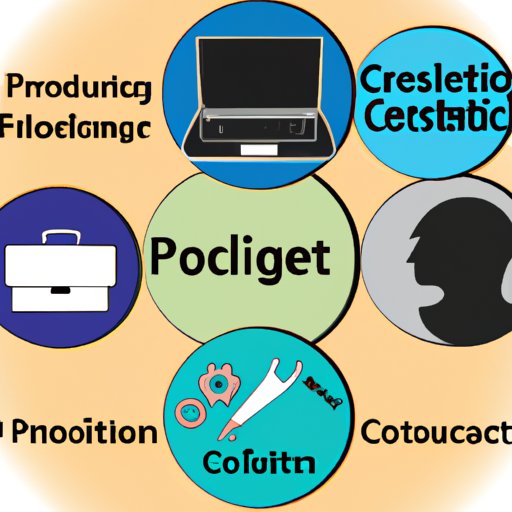Introduction
Having a well-crafted computer science portfolio can be a powerful tool when applying for jobs. It gives employers a clear picture of your skills and experience, and can make all the difference in standing out from other applicants. But what should go into a portfolio, and how do you put one together? This article will provide tips and strategies for creating a successful computer science portfolio.

Definition of a Computer Science Portfolio
A computer science portfolio is a collection of projects, achievements, and other professional materials that demonstrate your skills and experience in the field. It can include anything from academic projects to coding competitions, as well as relevant certifications or awards. Your portfolio should be tailored to showcase your strengths and highlight the particular areas of expertise you possess.
Purpose and Goals of a Computer Science Portfolio
The purpose of a computer science portfolio is to show employers that you have the skills and experience necessary to succeed in the job. It should demonstrate your abilities in programming languages, software development, and problem-solving. It should also illustrate your commitment to continuing education in the field, as well as any awards or recognitions you have received for your work.

Components of a Successful Computer Science Portfolio
When creating a computer science portfolio, there are several key components to consider. First, you need to identify relevant projects that showcase your skills and experience. Next, you must select the appropriate materials to include in your portfolio. Finally, you will need to present your skills in an attractive way.
Identifying Relevant Projects
When selecting projects for your portfolio, choose those that best demonstrate your abilities in the areas employers are looking for. For example, if you are applying for a job as a web developer, you may want to include projects related to HTML, CSS, JavaScript, and other web technologies. If you are applying for a position as a software engineer, you may want to include projects related to algorithms, data structures, and object-oriented programming. You should also consider any awards or recognitions you have received for your work.
Selecting Appropriate Materials
Once you have identified the projects that you want to include in your portfolio, you need to decide what materials to include. Depending on the project, this could range from source code to screenshots and diagrams. You may also want to include any relevant documentation such as user manuals or design specifications. When selecting materials, remember to keep them concise and focused on the most important aspects of the project.
Showcasing Your Skills
Your portfolio should also include a summary of your skills and experience. This can include a list of the programming languages and technologies you are familiar with, as well as any certifications or awards you have received. This section should be used to highlight your strengths and differentiate yourself from other applicants.
Organizing a Computer Science Portfolio
Once you have identified the projects and materials to include in your portfolio, you need to decide how to organize it. This can be done in either a physical or digital format. The format you choose will depend on how you plan to present your portfolio to employers.
Choosing an Appropriate Format
If you plan to present your portfolio in person, you may want to consider a physical format such as a printed book or binder. This allows you to create a professional-looking presentation that can be easily transported. Alternatively, if you plan to present your portfolio online, you may want to consider a digital format such as a website or PDF document.
Presenting Your Projects in an Attractive Way
Regardless of the format you choose, you should strive to present your projects in an attractive and organized way. Use visuals such as screenshots and diagrams to draw attention to key points. When possible, use color and other design elements to make your portfolio visually appealing. Additionally, make sure all of your projects are clearly labeled and easy to find.
Creating an Online Portfolio
Creating an online portfolio can be a great way to showcase your work and make it accessible to potential employers. There are many platforms available for hosting an online portfolio, such as WordPress, Wix, and Squarespace. Each platform has its own advantages and disadvantages, so be sure to research the different options before making a decision.
Benefits of Hosting an Online Portfolio
An online portfolio has several advantages over a traditional physical portfolio. It can reach a much larger audience, as potential employers can access it from anywhere with an internet connection. An online portfolio also makes it easier to keep your projects up-to-date, as you can quickly add new projects or make changes to existing ones. Additionally, an online portfolio can be a great way to show off your web development skills.
Tips for Designing an Effective Website
When designing an online portfolio, there are several tips to keep in mind. First, make sure the design is clean and uncluttered. Too much visual clutter can make it difficult for visitors to find what they’re looking for. Additionally, ensure that all of your projects are easy to find and navigate. Make sure to include a contact page so employers can easily get in touch with you. Finally, consider using a content management system (CMS) such as WordPress to make it easier to update and maintain your portfolio.

Presenting a Computer Science Portfolio to Employers
Once you have created your portfolio, you need to decide how to present it to employers. Whether you are presenting it in person or online, there are several strategies you can use to maximize its impact.
Making a Good First Impression
First impressions are important, so make sure you present your portfolio in an organized and professional manner. If you are presenting it in person, dress appropriately and arrive on time. If you are presenting it online, make sure it is free of spelling and grammar mistakes. Additionally, include a brief introduction that explains why you are the right person for the job.
Strategies for Maximizing Impact
When presenting your portfolio, focus on the projects that best demonstrate your skills and experience. Highlight the most impressive features of each project and explain how it relates to the job you are applying for. Additionally, be prepared to answer questions about your projects and discuss them in more detail. This will show employers that you are knowledgeable about the topics you are presenting.
Conclusion
A computer science portfolio is an important tool for demonstrating your skills and experience to potential employers. It should include relevant projects, materials, and a summary of your skills and experience. When organizing your portfolio, choose a format based on how you plan to present it. An online portfolio is a great option, as it can reach a larger audience and make it easier to keep your projects up-to-date. Finally, when presenting your portfolio, focus on the projects that best demonstrate your abilities and be prepared to discuss them in more detail.
(Note: Is this article not meeting your expectations? Do you have knowledge or insights to share? Unlock new opportunities and expand your reach by joining our authors team. Click Registration to join us and share your expertise with our readers.)
